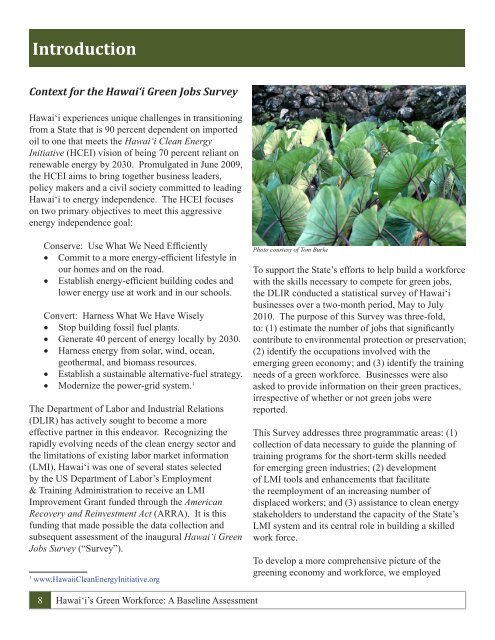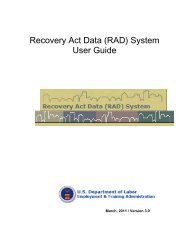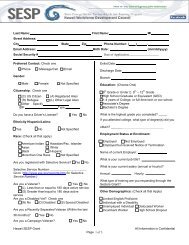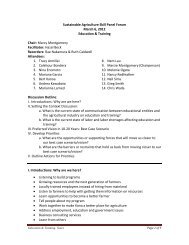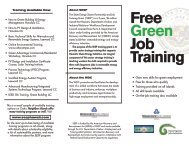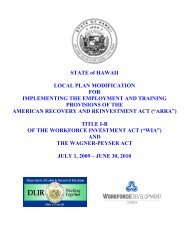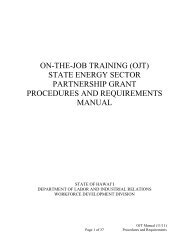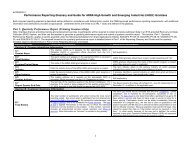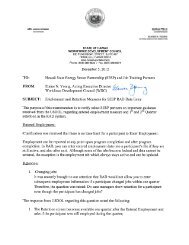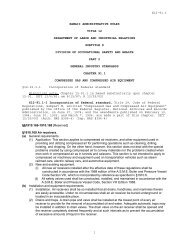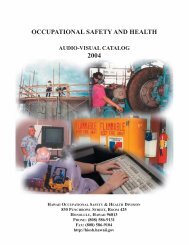Hawai i's Green Workforce A Baseline Assessment December 2010
Hawai i's Green Workforce A Baseline Assessment December 2010
Hawai i's Green Workforce A Baseline Assessment December 2010
You also want an ePaper? Increase the reach of your titles
YUMPU automatically turns print PDFs into web optimized ePapers that Google loves.
Introduction<br />
Context for the <strong>Hawai</strong>‘i <strong>Green</strong> Jobs Survey<br />
<strong>Hawai</strong>‘i experiences unique challenges in transitioning<br />
from a State that is 90 percent dependent on imported<br />
oil to one that meets the <strong>Hawai</strong>‘i Clean Energy<br />
Initiative (HCEI) vision of being 70 percent reliant on<br />
renewable energy by 2030. Promulgated in June 2009,<br />
the HCEI aims to bring together business leaders,<br />
policy makers and a civil society committed to leading<br />
<strong>Hawai</strong>‘i to energy independence. The HCEI focuses<br />
on two primary objectives to meet this aggressive<br />
energy independence goal:<br />
Conserve: Use What We Need Efficiently<br />
• Commit to a more energy-efficient lifestyle in<br />
our homes and on the road.<br />
• Establish energy-efficient building codes and<br />
lower energy use at work and in our schools.<br />
Convert: Harness What We Have Wisely<br />
• Stop building fossil fuel plants.<br />
• Generate 40 percent of energy locally by 2030.<br />
• Harness energy from solar, wind, ocean,<br />
geothermal, and biomass resources.<br />
• Establish a sustainable alternative-fuel strategy.<br />
• Modernize the power-grid system. 1<br />
The Department of Labor and Industrial Relations<br />
(DLIR) has actively sought to become a more<br />
effective partner in this endeavor. Recognizing the<br />
rapidly evolving needs of the clean energy sector and<br />
the limitations of existing labor market information<br />
(LMI), <strong>Hawai</strong>‘i was one of several states selected<br />
by the US Department of Labor’s Employment<br />
& Training Administration to receive an LMI<br />
Improvement Grant funded through the American<br />
Recovery and Reinvestment Act (ARRA). It is this<br />
funding that made possible the data collection and<br />
subsequent assessment of the inaugural <strong>Hawai</strong>‘i <strong>Green</strong><br />
Jobs Survey (“Survey”).<br />
1 www.<strong>Hawai</strong>iCleanEnergyInitiative.org<br />
8 <strong>Hawai</strong>ÿi’s <strong>Green</strong> <strong>Workforce</strong>: A <strong>Baseline</strong> <strong>Assessment</strong><br />
Photo courtesy of Tom Burke<br />
To support the State’s efforts to help build a workforce<br />
with the skills necessary to compete for green jobs,<br />
the DLIR conducted a statistical survey of <strong>Hawai</strong>‘i<br />
businesses over a two-month period, May to July<br />
<strong>2010</strong>. The purpose of this Survey was three-fold,<br />
to: (1) estimate the number of jobs that significantly<br />
contribute to environmental protection or preservation;<br />
(2) identify the occupations involved with the<br />
emerging green economy; and (3) identify the training<br />
needs of a green workforce. Businesses were also<br />
asked to provide information on their green practices,<br />
irrespective of whether or not green jobs were<br />
reported.<br />
This Survey addresses three programmatic areas: (1)<br />
collection of data necessary to guide the planning of<br />
training programs for the short-term skills needed<br />
for emerging green industries; (2) development<br />
of LMI tools and enhancements that facilitate<br />
the reemployment of an increasing number of<br />
displaced workers; and (3) assistance to clean energy<br />
stakeholders to understand the capacity of the State’s<br />
LMI system and its central role in building a skilled<br />
work force.<br />
To develop a more comprehensive picture of the<br />
greening economy and workforce, we employed


